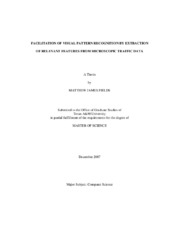| dc.description.abstract | An experimental approach to traffic flow analysis is presented in which methodology
from pattern recognition is applied to a specific dataset to examine its utility in
determining traffic patterns. The selected dataset for this work, taken from a 1985 study
by JHK and Associates (traffic research) for the Federal Highway Administration,
covers an hour long time period over a quarter mile section and includes nine different
identifying features for traffic at any given time. The initial step is to select the most
pertinent of these features as a target for extraction and local storage during the
experiment. The tools created for this approach, a two-level hierarchical group of
operators, are used to extract features from the dataset to create a feature space; this is
done to minimize the experimental set to a matrix of desirable attributes from the
vehicles on the roadway. The application is to identify if this data can be readily parsed
into four distinct traffic states; in this case, the state of a vehicle is defined by its velocity
and acceleration at a selected timestamp. A three-dimensional plot is used, with color as
the third dimension and seen from a top-down perspective, to initially identify vehicle
states in a section of roadway over a selected section of time. This is followed by
applying k-means clustering, in this case with k=4 to match the four distinct traffic states, to the feature space to examine its viability in determining the states of vehicles in
a time section. The method’s accuracy is viewed through silhouette plots. Finally, a
group of experiments run through a decision-tree architecture is compared to the kmeans
clustering approach. Each decision-tree format uses sets of predefined values for
velocity and acceleration to parse the data into the four states; modifications are made to
acceleration and deceleration values to examine different results.
The three-dimensional plots provide a visual example of congested traffic for use
in performing visual comparisons of the clustering results. The silhouette plot results of
the k-means experiments show inaccuracy for certain clusters; on the other hand, the
decision-tree work shows promise for future work. | en |


